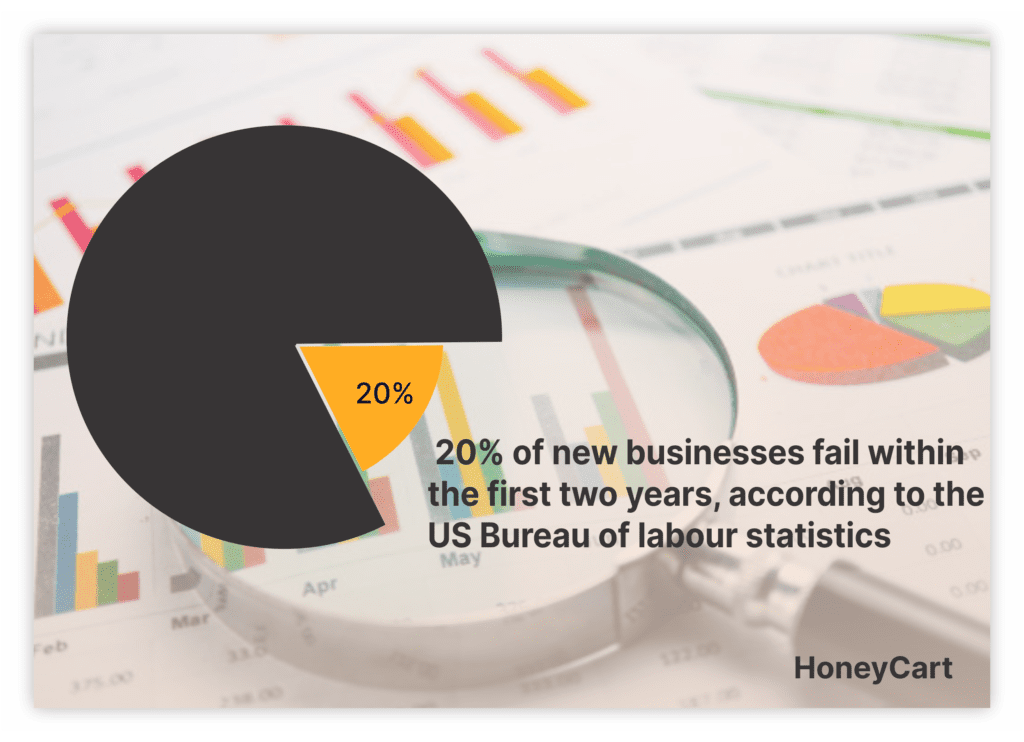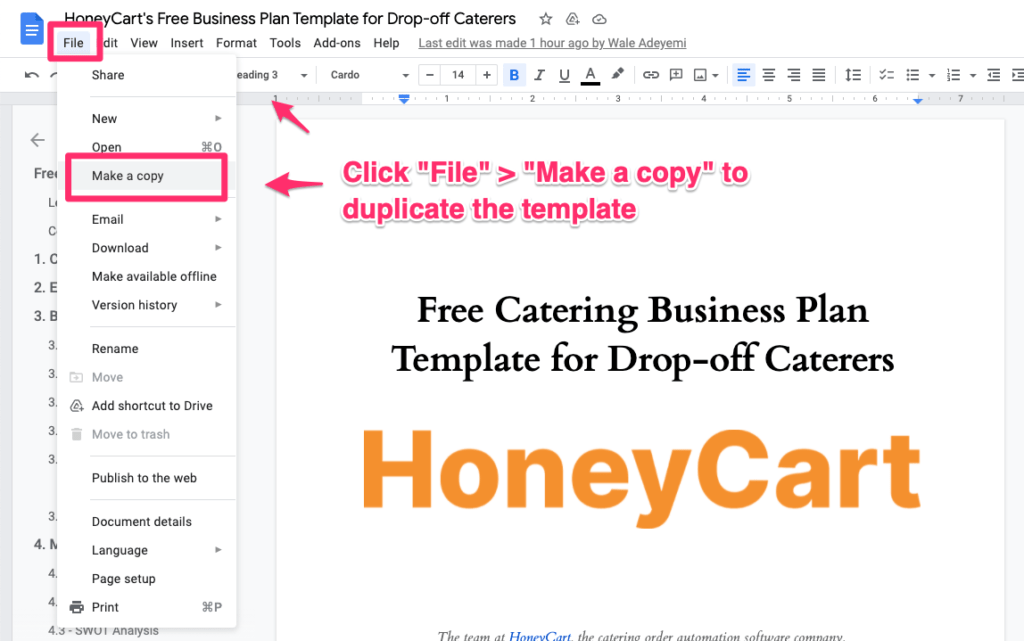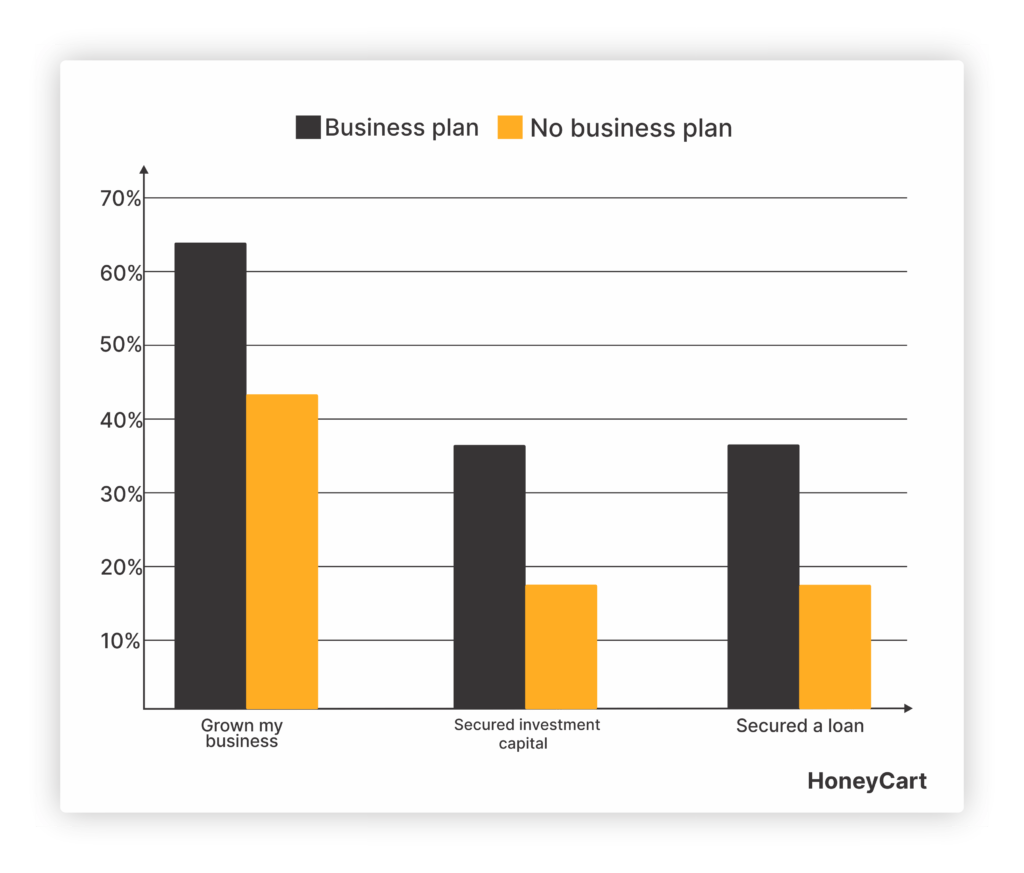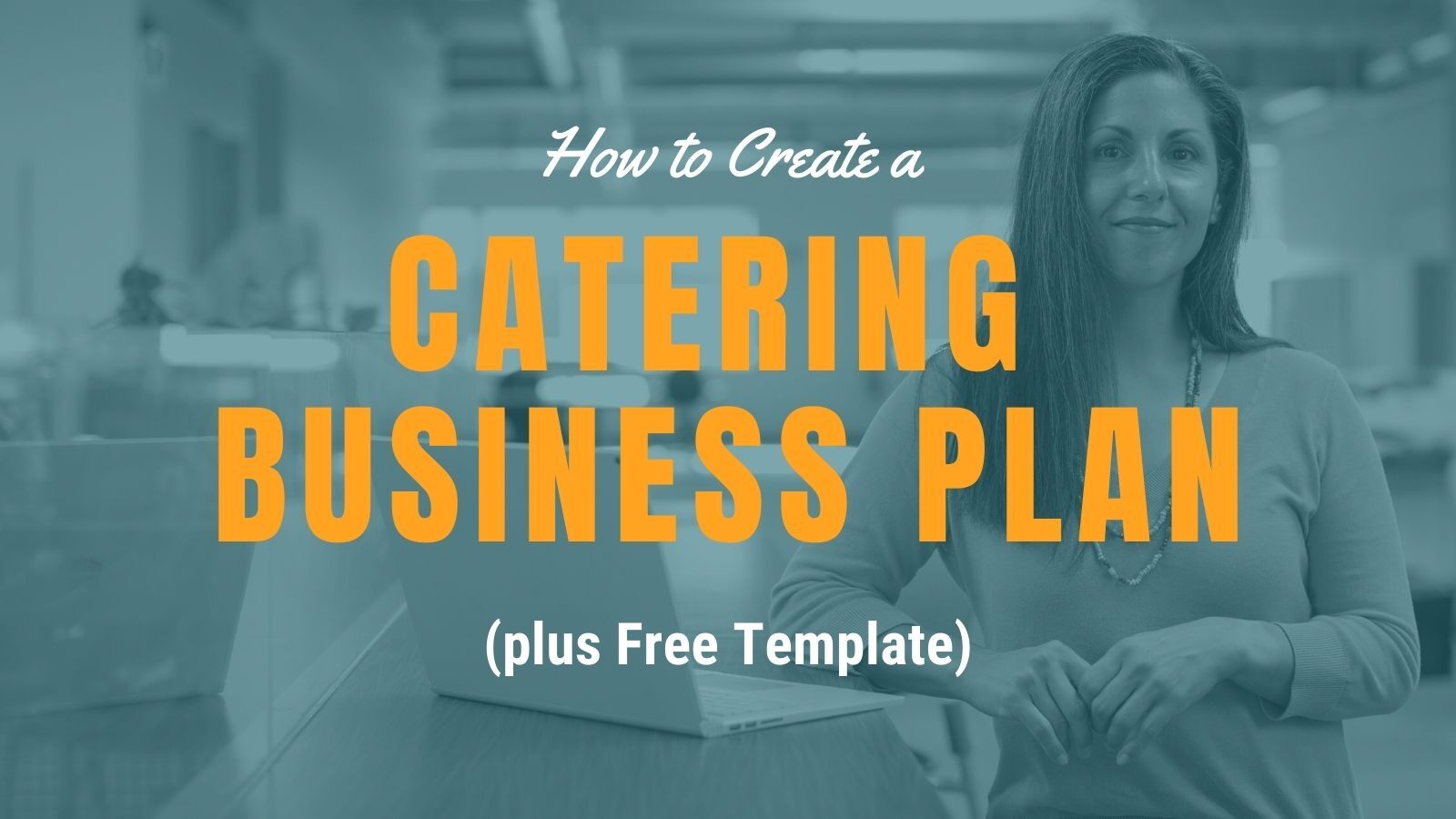Elizabeth started her career at a small local restaurant close to her home. She had big dreams of owning a large catering business.
Three years later, she learned the ropes, worked hard enough to save money and was ready to launch Chefdini Catering.
Hers is a tale of overcoming all odds.
Within five years, Elizabeth expanded her operations. She employed some staff and was raking in around $5 million in revenue annually.
In an era where 20% of new businesses fail within the first two years, according to the US Bureau of Labor Statistics, how did Elizabeth pull this off?

Well, it may have taken five years, but one thing that helped her navigate her journey smoothly was:
…a Catering Business Plan.
And she’s not alone. About 70% of new businesses that manage to survive for five years follow a strategic business plan in the US.
So while several factors contribute to businesses failing within the first couple of years, there’s no doubt lack of a business plan is a major reason.
And this isn’t far-fetched.
Imagine building a house without floor plans. How long do you think it’s going to stand? Not long enough.
That’s precisely what happens when you operate your drop-off catering business without a solid plan. And this has nothing to do with how passionate you are.
Think of a business plan as a roadmap or a guide that outlines your goals and details how you intend to achieve them. It’s central to how you start and grow your business. Also, it turns your visions into a concrete action plan for success.
Having a plan is essential for drop-off caterers hoping to thrive in the current, highly competitive catering industry.
As you read this, over 12,000 establishments are vying for the same customer as you. So running a catering business without a solid plan will only give an opening for your competitors to be many steps ahead of you.
Take Abbey Duke, CEO of SugarSnap Catering, for instance.
From the get-go, part of her strategy was to always stay competitive by serving her customers how they prefer.
So when the pandemic hit and online ordering became the norm, she quickly leaned on HoneyCart’s order automation software to give customers the convenience they desired. And at the same time, to ensure she wasn’t losing sales to her competitors.
In her words:
“But I knew if we didn’t offer online ordering, we’d be losing sales to companies like Panera that make it easy to order. Busy customers expect convenience and will often choose it over quality.”
Making this kind of game-changing decision at a moment’s notice is one of the perks of having a solid business plan.
Now, you may be wondering:
“How do I create an effective catering business plan?” One that gives you an edge over your competitors and sets you on the path to success like Elizabeth.
Well, I got you covered.
We’ve developed a free catering business plan template you can customize to your specific needs. I know, creating a business plan, even with a free template, is still a daunting task for drop-off caterers.
Don’t worry.
As we progress through this article, I’ll guide you on how to create one step-by-step.
Download the free template to follow along with me:

Before we dive in, let’s take a look at some reasons why you must have a catering business plan.
Five Reasons Why You Need a Catering Business Plan
1. It Shows You Mean Business
Today, technology has made it easy for anyone to start a catering business. Even amateurs can create an Instagram account, post some mouthwatering dishes and wait for orders to flood in.
But is this strategy going to cut it in the long run?
Absolutely not!
If you intend to scale your business, then it starts with a foolproof business plan. One that gives you insight into where your business is headed in the next five to ten years.
Having a business plan also emphasizes the commitment of you and everyone involved. It guides you in making smart decisions that will help scale your operations.
However, a catering business plan isn’t set in stone. This means you can change the plan as you progress. But the overall goals remain the same.
2. It Increases Your Chances of Securing Investments
Take Elizabeth, the fictional character I used at the start of this article.
One reason she could expand her business within five years is that she secured investment and raised funds.
And what’s one crucial thing potential investors will ask before giving you funds?
Yep, that’s right – a well-detailed business plan.
Imagine she didn’t have one. She wouldn’t have been able to raise the funds needed to expand her operations.
Here’s why:
Investors like to see your plans for scaling the business, its financial projections, industry analysis, level of risk involved, and so on.
Not having a business plan shows you are not intentional about scaling. And this significantly reduces the chances of securing funds needed to expand.
To drive home my point, Tim Berry, founder of Palo Alto Software, did a survey asking his customers questions about their businesses, goals, and business planning.
The result?

From the above report, you’ll see that those who had business plans were almost twice more likely to grow their businesses by securing capital than those who didn’t write a plan.
This emphasizes the importance of having a business plan.
3. It Helps You Understand Your Competitors
A business plan isn’t complete without researching and analyzing your competitors.
Why?
Because it helps you understand what they are doing, their offerings, pricing, and how you can improve on them.
Michele Levy, an independent brand strategy consultant agrees:
“Keeping track of who your competitors are, what people are saying about them, and what they are saying themselves can help you differentiate your business and stay ahead of trends that could impact your business.”
Furthermore, it’s a way to:
- Learn more about the latest market trends
- Recognize opportunities your competitors don’t offer
- Get an idea of your ideal customer persona
- Threats to your business
- Understand the catering industry better.
As a result, you can create a strategic plan that will improve your business.
4. Discover New Opportunities
Another benefit of creating a catering business plan is discovering new opportunities to boost your business in ways you never imagined.
Through research and competitive analysis, you may realize there are one or more niches that are underserved in your area.
So, instead of doing what every other drop-off caterer does, you can carve out a niche for yourself by doing something different.
For example, during the global pandemic that crippled catering activities, Chef Jolie of Low Country Quisine needed another source of revenue.
So she went back to the drawing board.
The result? She launched a Gourmet Takeaway Service.
By making it a habit to spot opportunities in market trends, she realized the need for an online ordering platform.
According to her:
“We needed to find new ways to generate revenue during the pandemic. We launched our Gourmet Takeaway Service and needed an online platform for customers to order.”
And if she didn’t do this, here’s what would have happened:
“We would not have been able to reach as many customers without the ability to accept orders and payments online.”
5. Measure the Success of Your Business
One of the goals of running a business is to hit milestones and achieve major goals.
And the only way to measure your success is to compare results with the actual plan. This way, you can see whether you’ve achieved your operational and financial goals within a specific timeframe.
For example, you set a goal of getting at least 150 customers within six months, expanding to at least four locations within 12 months, or like Elizabeth, hit $5 million annually.
By documenting these goals, not only does it make you committed to achieving them, but it also ensures you have something to measure your success against.
And it will give you a sense of fulfillment when you finally accomplish your goals. Without a doubt, a well-documented business plan fast-tracks achieving your goals.
Now that you know the importance of a catering business plan, let’s look at the essential elements of an ideal business plan.
Essential Elements of a Catering Business Plan
Creating a catering business plan may sound like a daunting task. But in reality, it isn’t. It’s not much different from the usual business plan.
However, it focuses on elements specific to the food and catering industry.
So what are these elements?
- Confidentiality Agreement
- Executive Summary
- Business Focus
- Market Research
- Marketing Plan
- Financial Plan
- Appendix
Let’s take a brief look at what each of these elements should contain.
Want to create yours as you go through this guide?
Don’t forget to download (and make a copy) of the template here.
1. Confidentiality Agreement
How do you ensure anyone reading your business plan doesn’t disclose the content to other people?
That’s where a confidentiality agreement comes in.
It’s an agreement between you and anyone reading your business plan not to reveal the content to any other person without your permission.
And to be on the safe side, you should have a proper legal counsel review any agreement you use in your business.
So if they do reveal the content, you will have the right protections in place.
Here’s an example of a confidentiality agreement:
The undersigned reader of [Company’s Name] Business Plan acknowledges that the information provided is completely confidential. Therefore, the reader agrees not to disclose anything found in the business plan without the express written consent of [Business Owner’s Name].
It is also acknowledged by the reader that the information to be furnished in this business plan is in all aspects confidential in nature, other than information that is in the public domain through other means, and that any disclosure or use of the same by the reader may cause serious harm and or damage to [Company Name].
Upon request, this business plan document will be immediately returned to [Business Owner’s Name].
This is a business plan. It does not imply an offer of any securities.
Applicable Law
This contract shall be governed by the laws of the County of ________ in the State of _______ and any applicable Federal law.
________________________________
Signature
________________________________
Printed Name
2. Executive Summary
They say you only get one chance at a first impression. An executive summary is an opportunity to show anyone reading it what your catering business is about.
Chances are, if it lacks specific information or doesn’t capture the reader’s attention, they may not read further.
The executive summary should include a brief introduction to your catering business, your services, and who you cater to.
Here’s an example of an executive summary of Elizabeth’s fictional catering business.
Chefdini is a small catering business located in Georgia. It was founded by Elizabeth White six years ago. We specialize in Asian cuisine but also cater to Mexican and Italian dishes. Chefdini operates off-premise and on-premise catering with a focus on events, retreats, and social gatherings.
At a glance, this brief introduction shows what Chefdini is about, the kind of cuisines they specialize in, and who their audience is. Anyone who reads it can immediately get an idea of what to expect.
3. Business Focus
The business focus details how you’ll run your business, so anyone reading it will have a clear understanding of plans, goals, and priorities.
Information to include in your business focus are:
- Mission statement: an action-based statement that declares the purpose of your business, what you want to achieve, and how you intend to do it.
- Business details: a summary of your business, the founders, business location, services, and ethos.
- Professional support: details of any professional help you have received from an individual, an organization, or the government.
- Founders: history and background of anyone involved in starting the business
- Team members: details of those involved in the operations of the business and their roles.
- Aims & Objectives: as the name implies, here you include the details of what you hope to achieve with your business and the steps you’ll take to achieve it. Your aims and objectives can be short, medium, or long-term.
4. Market Research
Dan Zarrella, an analytical marketing leader and author of four books on marketing once said:
“Marketing without data is like driving with your eyes closed.”
And how do you get this data? Through Market Research.
Market research is the process of gathering information to understand your target market better. As such, it’s a fundamental part of a business plan.
Under market research, you’ll find:
Client Research
Your clients are the set of people who need your catering services and are most likely to pay for them.
To have any chance of making sales, you need to understand your ideal customers, their pain points, challenges, and how you can take them from point A to their desired point B.
So, any information related to the ideal clients like age, location, gender, income, interests, pain points, or goals would add value here.
The goal is to ensure you are not targeting the wrong audience, which would result in wasted efforts.
But when you narrow down your target audience, you will be better placed to tailor your offerings to fulfill their needs.
Competitor Profiling
As I mentioned earlier, competition in the catering industry gets tougher each day, with more caterers and restaurants springing up. But this doesn’t mean there isn’t enough space in the sky for birds to fly.
However, it’s important to know how to stand out.
And one way to do this is to research your competitors to learn more about their strengths and weaknesses. This way, you’ll discover things that will give you an edge over them.
In addition, well-detailed research about the competition will help you make a realistic assessment of your chances of success in the industry.
Some of the things to add under competitor profiling are:
- Competitor’s Name
- History
- Location
- Products/services offered
- Pricing
- Revenue
- Target audience
SWOT Analysis
The word SWOT is an acronym for Strengths, Weaknesses, Opportunities, and Threats.
A SWOT analysis is used to evaluate your business’s chances of success and develop a strategic plan. Here you analyze internal and external factors that may help scale your business or throw a wrench in your growth.
5. Marketing Plan
A comprehensive catering marketing strategy will be crucial to your success. After all, people will only patronize you if they know your business exists.
How do you plan to market your business? Where are you going to get catering clients from? Which channels do you plan to reach them? What’s your marketing budget?
All these are questions that need answers. So you must include your plans for marketing in your catering business plan. A solid marketing plan should contain:
- Service
- Unique Selling Point
- Pricing Policy
- Sales & marketing strategy
Don’t forget we have sections in our free template to fill all essential marketing points listed above. Download it here if you haven’t.
6. Financial Plan
Without a doubt, you need money to finance your catering business. But if you don’t have adequate financing, your business will struggle.
Because you’ll need to pay for space, pay your staff, pay for equipment and so on. All these require a sufficient amount of funds.
And if you plan to take online orders, investing in online ordering software is a no-brainer. This will help you:
- Process orders faster
- Make it convenient for your customers to order
- Save more time
- Streamline operations without the need for hiring additional staff, thereby saving cost
- And generate more revenue for your business.
So if you want to finance your catering business yourself, a financial plan helps you understand how much funds you need, where to cut expenses and what you need to do to become financially sustainable.
And if you plan to source funds through investors, it will provide them with enough information to determine whether they’ll get their return on investment.
Some of the things you need to include in your financial plan are:
- Startup costs
- Sales forecasts
- Cash Flow forecasts
- Other financials
Want to know what to fill in these sections? We’ve got you covered. Simply download and make a copy of our free template to fill all essential financial plans listed above.
7. Appendix
This is where you add additional information that is referenced in the business plan.
It can include things like:
- Financial charts / graphics
- CV’s / Resumes
- References
- Images of work
- Partnership Agreements
Conclusion: Scale Your Catering Business with an Actionable Business Plan
As you’ve seen, creating a business plan is not as difficult as it sounds.
It doesn’t matter whether you’ve started your business or you are just about to start. A catering business plan is crucial to the success of your business.
It helps you understand your business, your customers, and your competitors. Also, it gives you more insight into the catering industry, market trends, threats, and opportunities.
Another advantage of a business plan is the opportunity to set a budget aside for investing in important things that will contribute to your company’s growth.
For example, investing in commission-free catering software like HoneyCart helps you manage your catering operations without hiring more staff.
This levels the playing field for small business caterers, helps you save cost, and generate more revenue. Just as Abbey Duke, founder of SugarSnap Catering, realized when she switched to HoneyCart.
In her words:
It automates mundane tasks to allow us to use our time as efficiently as possible. HoneyCart truly enables small caterers to compete with larger companies by having a really professional and easy-to-use online ordering system.
Want to see how it works?
Start your 14-day free trial right away.

